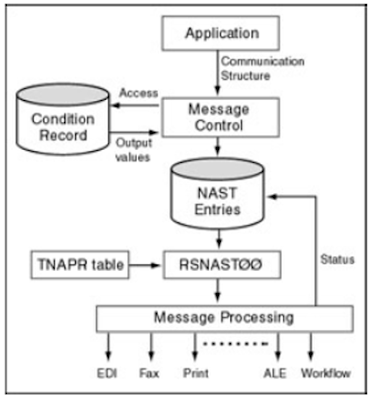1.Output proposal: Message control checks various business rules and proposes various output types.
2.Output editing: The user accepts or changes the proposed output types.
3.Output processing: The system processes the final list of output types to produce the actual outputs.
They are discussed in detailed below.
Output Proposal
The process described in figure below begins when an application document is created or changed. The application program fills the communication structure with values from the application data entered on the screen. This communication structure is passed to the Message control, along with the application ID and the procedure.
The various output types defined in a procedure are processed one at a time. They are mutually independent, so the results of one do not affect the other outputs. An output type marked as manual in a procedure is not used for an automatic proposal. Only the end user can manually select this output. This approach can be important when we do not want an automatic proposal or when business rules are based on human intelligence and cannot be encapsulated in an ABAP routine.
 The processing of output types that are not marked as manual is as follows. If we specify a requirement for an output type in the procedure, the code behind the requirement is executed to see whether the output type meets the requirements or preconditions. If requirements are met, further checking continues. If the output type does not meet the requirements, the next output type in the list is processed. (For example, a sales order response should not be sent out unless the sales order is complete.)
The processing of output types that are not marked as manual is as follows. If we specify a requirement for an output type in the procedure, the code behind the requirement is executed to see whether the output type meets the requirements or preconditions. If requirements are met, further checking continues. If the output type does not meet the requirements, the next output type in the list is processed. (For example, a sales order response should not be sent out unless the sales order is complete.)After parsing the list of output types in a procedure, the system "short lists" the output types that meet the requirements or preconditions. In the case of output types for the SD modules (sales, shipping, and billing), the system checks whether the access condition flag is set for an output type. If the flag is not set, the values for the output medium and timing for the output type are determined from the customer master data. If the flag is selected, processing continues for determining the output medium and timing.
For each output type in which the access condition flag is set, the access sequence associated with the output type is used to access various business rules and determine which of these business rules are satisfied. A business rule is satisfied if the application values passed in the communication structure result in a condition record being found using the keys of the business rule.
The process is
Validate any requirements that exist for a business rule. If the result is negative, the current business rule is skipped, and the next business rule in the sequence is checked.
1. If a business rule passes the requirement check or a requirement is not specified, the condition table for that business rule is accessed for any condition records that match the application data passed in the communication structures.
2. If a match is found, the values of the partner function, partner number, output medium, output language, and output timing are copied for that output type, and the output type is considered as proposed.
3. If the business rule uses exclusive strategy, the process ends here, and the whole processing starts from the very beginning for the next output type.
4. If an inclusive strategy is used, the next business rule in the access sequence is processed. The
purpose of an inclusive strategy is to propose multiple outputs of the same type to different partners.
5.Two instances of the same output type cannot have identical output parameters.
Related Posts
EDI Message control configuration and part two
Maintaining partner profiles in EDI
EDI in bound parameters over view
Control table in message control
SAP ABAP SAMPLE CODE FOR MULTIPLE INTERACTIVE REPORT
SAP ABAP SAMPLE CODE MULTIPLE INTERACTIVE REPORT TWO
No comments :
Post a Comment